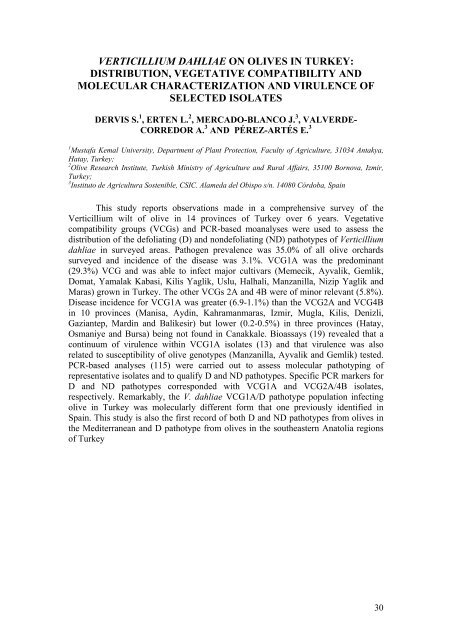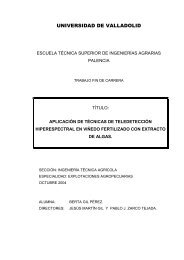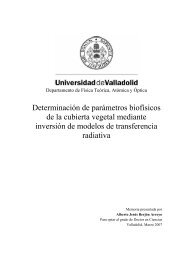10th INTERNATIONAL VERTICILLIUM SYMPOSIUM 16-20 ...
10th INTERNATIONAL VERTICILLIUM SYMPOSIUM 16-20 ...
10th INTERNATIONAL VERTICILLIUM SYMPOSIUM 16-20 ...
You also want an ePaper? Increase the reach of your titles
YUMPU automatically turns print PDFs into web optimized ePapers that Google loves.
<strong>VERTICILLIUM</strong> DAHLIAE ON OLIVES IN TURKEY:DISTRIBUTION, VEGETATIVE COMPATIBILITY ANDMOLECULAR CHARACTERIZATION AND VIRULENCE OFSELECTED ISOLATESDERVIS S. 1 , ERTEN L. 2 , MERCADO-BLANCO J. 3 , VALVERDE-CORREDOR A. 3 AND PÉREZ-ARTÉS E. 31 Mustafa Kemal University, Department of Plant Protection, Faculty of Agriculture, 31034 Antakya,Hatay, Turkey;2 Olive Research Institute, Turkish Ministry of Agriculture and Rural Affairs, 35100 Bornova, Izmir,Turkey;3 Instituto de Agricultura Sostenible, CSIC. Alameda del Obispo s/n. 14080 Córdoba, SpainThis study reports observations made in a comprehensive survey of theVerticillium wilt of olive in 14 provinces of Turkey over 6 years. Vegetativecompatibility groups (VCGs) and PCR-based moanalyses were used to assess thedistribution of the defoliating (D) and nondefoliating (ND) pathotypes of Verticilliumdahliae in surveyed areas. Pathogen prevalence was 35.0% of all olive orchardssurveyed and incidence of the disease was 3.1%. VCG1A was the predominant(29.3%) VCG and was able to infect major cultivars (Memecik, Ayvalik, Gemlik,Domat, Yamalak Kabasi, Kilis Yaglik, Uslu, Halhali, Manzanilla, Nizip Yaglik andMaras) grown in Turkey. The other VCGs 2A and 4B were of minor relevant (5.8%).Disease incidence for VCG1A was greater (6.9-1.1%) than the VCG2A and VCG4Bin 10 provinces (Manisa, Aydin, Kahramanmaras, Izmir, Mugla, Kilis, Denizli,Gaziantep, Mardin and Balikesir) but lower (0.2-0.5%) in three provinces (Hatay,Osmaniye and Bursa) being not found in Canakkale. Bioassays (19) revealed that acontinuum of virulence within VCG1A isolates (13) and that virulence was alsorelated to susceptibility of olive genotypes (Manzanilla, Ayvalik and Gemlik) tested.PCR-based analyses (115) were carried out to assess molecular pathotyping ofrepresentative isolates and to qualify D and ND pathotypes. Specific PCR markers forD and ND pathotypes corresponded with VCG1A and VCG2A/4B isolates,respectively. Remarkably, the V. dahliae VCG1A/D pathotype population infectingolive in Turkey was molecularly different form that one previously identified inSpain. This study is also the first record of both D and ND pathotypes from olives inthe Mediterranean and D pathotype from olives in the southeastern Anatolia regionsof Turkey30




